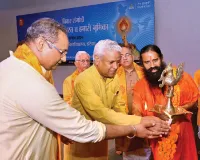Origin of Life
Caste-Animosity: Civilizations (Part 2)
On

Dr. Chandra Bahadur Thapa
Finance and Legal Consultant- Board of Education of India and Legal Consultant Patanjali Group
6) Civilization of Armenians
Armenian civilization, which includes some parts of present-day Turkey, Syria, Lebanon, Iran, Iraq, Azerbaijan and the territory of present-day Armenia, is one of the ancient civilizations. The name of Armenia in Armenian language is Hayastan which means the land of Hayk. Hayk was the name of Noah's great-great grandson. According to Islamic, Christian and Jewish beliefs, the boat of Noah (Nuh in Arabic, like the Hindu Matsya avatar) who saved people from the flood of the mythical great deluge, stopped near the hills of Yerawan. People of Armenian origin consider themselves to be the descendants of Hayk, the great-grandson of Noah (revered in Islam, Christianity and Jews). In the Bronze Age, it was the land of empires like Hittites and Mitanni. In the Iron Age, the Urartu Empire of Aram unified all the powers and this region was named Armenia after it. Some Christians believe that Noah (Nuh in Islam) and his family settled here. People of the Semitic race were the residents of this civilization. The founders of the Armenian script also belonged to this caste. The Armenian script Aramaic was once used (300 BC) from India to the Mediterranean Sea. The king of Armenia had accepted Christianity in the fourth century itself. Thus, the state of Armenia is the first state to adopt Christianity. The Armenian Apostolic Church is the largest religion in the country. Being located between the Eastern Roman Empire and both Persia and Arabian regions, it has been a land of foreign influence and war since the Middle Ages where many early wars of Islam and Christianity were fought. Apart from this, there is a small community of Catholic Christians, Muslims and other sects here. According to Zenob Glak (one of the first disciples of Armenia's Patron Saint Gregory the Illuminator), at least 7 Hindu cities were established in Armenia around 349 BC the institution of nakharar was established by Hindu kings even earlier. Zenob writes that the colony was founded by two Indian princes of Ujjain who took refuge in Armenia. They and their descendants worshipped Lord Ganesha and ruled a large part of Armenia. The rule of these Hindu kings lasted in Armenia and Hindu cities flourished there until 301 AD, when Christianity was introduced there. The Saint Karapet monastery ruins (now in Turkey) were formerly a Hindu temple on the site of the ruins. Literary evidence points to the existence of Indian settlements in Armenia as early as 149 BC. That is, the Armenians were also descendants of Sanatani ancestors before they became Christians and later Muslims.
7) Babylonian Civilization
Babylonia was a very ancient Akkadian-speaking state and cultural region developed in the city of Babylon in central-southern Mesopotamia (present-day Iraq and parts of Syria and Iran) and in the valleys of the Tigris and Euphrates rivers. It emerged as an Akkadian-populated but Amorite-ruled state around 1894 BC. The nomads of the Arabian desert took over the Sumerian kingdom and made the city of Babylon their capital. That is why this civilization was called the civilization of Babylonia. Hammurabi was the ruler of Babylon from 1792 BC to 1750 BC. The creators of the civilization of Babylonia were Semitic the Babylonians were people of the Semitic race, who lived like nomads in the regions around Sumeria. Attracted by the fertile land of Mesopotamia, they gradually started settling in this valley. In 2750 BC, the first tribe of this race fought with the residents of Sumeria and acquired some territories and established the kingdom of Akkad. Gradually this tribe progressed and around 2500 BC, the Akkadian 'ruler' 'Sargon the Great' established his authority over the whole of Mesopotamia. This ruler laid the foundation of the city of Babylon or Babylon. This civilization was also called the civilization of Babylonia after the name of this city. After two hundred years, the Akkadian Empire began to decline and other tribes of the Semitic race began to come to Mesopotamia. Around 2300 BC, the 'Elomite' tribe took over some cities in the south. After this, in 2200 BC, the Amorite tribe invaded Mesopotamia and defeated the Akkadian and Elomite tribes and established their authority over a large part of Mesopotamia. The most powerful ruler of this tribe was Hammurabi who ruled Mesopotamia from 1792 to 1750 BC. This ruler was a great conqueror, great administrator, politician and law maker. During his rule, there was a great development in architecture and revolutionary reforms took place in the field of law. After the death of Hammurabi, from 1570 BC to 1154 BC, the Hittites tribe from the west and the Kassites tribe from the east invaded and destroyed the empire of Babylonia. Later, Babylonia came under the control of Assyria and Egypt. After this, from 1121 BC to 562 BC, King Nebuchadrezzar-1 to King Nebuchadrezzar-II tried to re-establish the ancient glory of Babylonia and built hanging gardens. After the death of this ruler, the Iranians took over Babylonia. From 3000 BC to the reign of Hammurabi, the main cultural and religious center of southern Mesopotamia was the ancient city of Nippur, where the god Enlil was supreme. Hammurabi transferred this dominance to Babylon, making Marduk supreme in the pantheon of southern Mesopotamia was made (the god Ashur or Ishtar, northern Mesopotamia Assyria remained the dominant deity for a long time). Babylon the city became known as a 'sacred city' where any legitimate ruler of southern Mesopotamia was crowned, and for these religious reasons the city was also revered by the Assyrians. The Hittites, while plundering Babylon, removed the statues of the gods Marduk and his wife Zarpanitu from the Esagil temple and took them to their kingdom. Qaraindash built a bas-relief temple in Uruk and Kurigalzu (1415-1390 BC) built a new capital in his name, Dur-Kurigalzu, transferring administrative rule from Babylon. Both these kings struggled unsuccessfully against the Sealand dynasty. Qaraindash also strengthened diplomatic relations with the Assyrian king Ashur-bel-nisheshu and the Egyptian pharaoh Thutmose III and guarded Babylon's borders with Elam. Alexander conquered Babylon for the Greeks in 333 BC and died in 323 BC. Babylonia and Assyria then became part of the Greek Seleucid Empire. In 150 BC the Parthian king Mithridates conquered and incorporated the region into the Parthian Empire and the region became a battleground between the Greeks and the Parthians. The Babylonian system of mathematics was the sexagesimal or base 60 numeral system. From this we get the modern-day use of 60 seconds in a minute, 60 minutes in an hour, and 360 (60×6) degrees in a circle. The Babylonians were able to make great advances in mathematics for two reasons. First, the number 60 has many divisors (2, 3, 4, 5, 6, 10, 12, 15, 20, and 30), making calculations easier. Additionally, unlike the Egyptians and Romans, the Babylonians had a true place-value system, where the digits written in the left column represented larger values (734-7×100+3×10+4×1, similar to our base-ten system). The Babylonians' mathematical achievements included determining the square root of two accurately to seven places (YBC 7289). They also demonstrated knowledge of the Pythagorean theorem before Pythagoras.
8) Indus Valley Civilization
This civilization spread up to 'Manda' (Jammu Kashmir) in the north, 'Daimabad' (Maharashtra) in the south, 'Alamgirpur' (Uttar Pradesh) in the east and 'Sutkagendor' (Pakistan) in the west and was also spread in Saurashtra, Rajasthan, Haryana, Western Uttar Pradesh etc. Indus Valley Civilization (3300-1300 BC), World one of the ancient civilizations of the 1st century AD, spread across the Indus River and ancient Sarasvati River region in South Asia, also known as the Harappan Civilization. Its initial development took place between 7500-3300 BC, on the banks of Indus and Ghaggar/Hakra (ancient Saraswati river), whose main centers were Harappa, Mohenjodaro, Kalibanga, Lothal, Dholavira and Rakhigarhi. Bhirdana is considered to be the oldest city of Indus Valley Civilization discovered till date, which was settled between approximately 7500 to 6500 BC. Due to the evidence of this civilization found in the excavations of Harappa and Mohenjodaro, which fall in the region of Indus and its tributaries, scholars named it Indus Valley Civilization, but later the remains of this civilization were also found in Ropar, Lothal, Kalibanga, Banavali, Rangpur etc., which were outside the region of Indus and its tributaries. Punjab and Sindh became the center, the area of this civilization was many times bigger and vaster than the area of all the ancient civilizations of the world, gradually it expanded towards south and east. Thus, Harappan culture included not only Punjab, Sindh and Baluchistan but also the border areas of Gujarat, Rajasthan, Haryana and western Uttar Pradesh, i.e. from the banks of Chenab river in Manda in the north to Daimabad (Maharashtra) in the south and from Sutkagendor of Makran coast of Baluchistan in the west, Sindh province of Pakistan to Hiranya in Alamgirpur, Meerut and Kurukshetra in the north-east. In the initial expansion, the entire area was triangular (from Manda of Jammu in the north to Bhogtrar of Gujarat in the south and from Sutkagendor of Afghanistan in the west to Meerut of Uttar Pradesh in the east) and the area was 20,00,000 square kilometres, i.e. it was bigger than modern or ancient Egypt and Mesopotamia. Till now, a total of 1500 sites of this culture have been discovered in the Indian subcontinent. Some of these are of the initial stage, some of the mature stage and some of the later stage. A large number of female statues made of baked clay have been found in Harappa. One statue shows a plant emerging from a woman's womb. Scholars believe that this is the statue of the Earth Goddess and it must have been closely related to the birth and growth of plants. Therefore, it seems that the people here considered the earth to be the goddess of fertility and worshipped it in the same way (the way the Egyptians worshiped Isis, the goddess of the Nile River). But it is difficult to say whether the society here was also matriarchal like ancient Egypt or not. Some Vedic texts praise Mother Earth, a well has been found in the fort of Dholavira, it has stairs going downwards and there was a window in it where there is evidence of lighting a lamp. The water of Saraswati river used to come in that well, so perhaps the people of Indus Valley used to worship Saraswati through that well. A seal is found in the cities of Indus Valley Civilization which has a picture of a yogi with 3 or 4 faces, many scholars believe that this yogi is Shiva. In Mewar which was once in the boundary of Indus Valley Civilization, even today Eklingnath ji, the incarnation of Shiva with 4 faces, is worshipped. The people of Indus Valley Civilization used to cremate their dead bodies, the population of cities like Mohenjodaro and Harappa was around 50 thousand but still only around 100 graves have been found from there which indicates that they used to cremate dead bodies. Havan kunds have been found at places like Lothal, Kalibanga etc. which is proof of them being Vedic. Pictures of Swastika have also been found here. Some scholars believe that Hinduism was the original religion of Dravidians and Shiva was the god of Dravidians who was adopted by the Aryans. Some Jain and Buddhist scholars also believe that the Indus Valley Civilization belonged to Jain or Buddhist religion. Archaeologists have found remains of many temples in ancient Egypt and Mesopotamia but no temple has been found in the Indus Valley till date. Historians believe that the people of the Indus Valley used to worship in their homes, in the fields or on the river banks. Just as Hindus today go to bathe in the Ganges, the Indus people used to purify themselves by bathing here. Like ancient Mesopotamia, the people here also invented the art of writing. The first sample of the Harappan script was found in 1853 AD and the entire script came to light in 1923 but it has not been read till date. Due to the knowledge of the script, accounting of personal property became easy. They needed measurement and weighing for trade and they also used it. Many items like weights have been found. They show that 16 or its multiples (like 16, 32, 48, 64, 160, 320, 640, 1280 etc.) were used in weighing. The interesting thing is that till modern times, 1 rupee in India was equal to 16 annas. There were 4 paavs in 1 kg and 4 kanwans in every paav, that is, a total of 16 kanwans in a kg. According to most scholars, this civilization ended due to the outbreak of floods. Since the Indus Valley civilization developed along the banks of rivers, floods were natural, so this argument is universally accepted. But some scholars believe that such a huge civilization cannot end due to floods alone. Therefore, different scholars support different reasons other than floods, such as fire, epidemic, external invasion.
Etcetera.
Tags: Origin of life
लेखक
Related Posts
Latest News
01 Dec 2024 18:59:48
योग प्रज्ञा योग - योग जीवन का प्रयोजन, उपयोगिता, उपलब्धि, साधन-साधना-साध्य, सिद्धान्त, कत्र्तव्य, मंतव्य, गंतव्य, लक्ष्य, संकल्प, सिद्धि, कर्म धर्म,...














.jpg)




